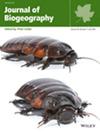Glacial History and Ecological Restrictions Shape Island-Scale Genetic Structure and Demography in the Southernmost Bird of Prey
Abstract
Aim
To understand the influence of Andean uplifts and glacial cycles on South American biodiversity, we delve into the population genetics and evolutionary history of a unique subantarctic island raptor specialised in exploiting marine food webs.
Location
Islands in Tierra del Fuego and Malvinas/Falklands.
Time period
Last glacial period to the present.
Taxon
Phalcoboenus australis.
Methods
We used RAD sequencing to assess genetic diversity, population structure and to model demographic history through descriptive and hypothesis-based evolutionary methods.
Results
We found evidence of two independent lineages: one inhabiting the Fuegian archipelago and the other one occurring in the Islas Malvinas/Falkland Islands, with the latter presenting higher genetic diversity and evidence of finer-scale population structure. The best supported demographic scenario places the divergence time of these lineages during the last glacial period (ca. 50,000 years ago), with the occurrence of gene flow during the first 27,000 years after their divergence. Recent demographic modelling supports the general pattern of increasing genetic variability as landmasses were uncovered following the glacial period (i.e., the Fuegian archipelago) in contrast with a decrease in genetic diversity associated to island fragmentation (i.e., in the Islas Malvinas/Falkland Islands).
Main Conclusions
We propose that post-glacial sea level rise and the subsequent isolation across the submerging Patagonian Shelf have driven population fragmentation and recent genetic structure in this species. Our findings advocate for recognising the two identified divergent lineages as distinct conservation units. We highlight the intricate interplay of ecological factors, glacial cycles and population dynamics in shaping the evolutionary trajectory of this unique and threatened raptor species in southern South America.

 求助内容:
求助内容: 应助结果提醒方式:
应助结果提醒方式:


